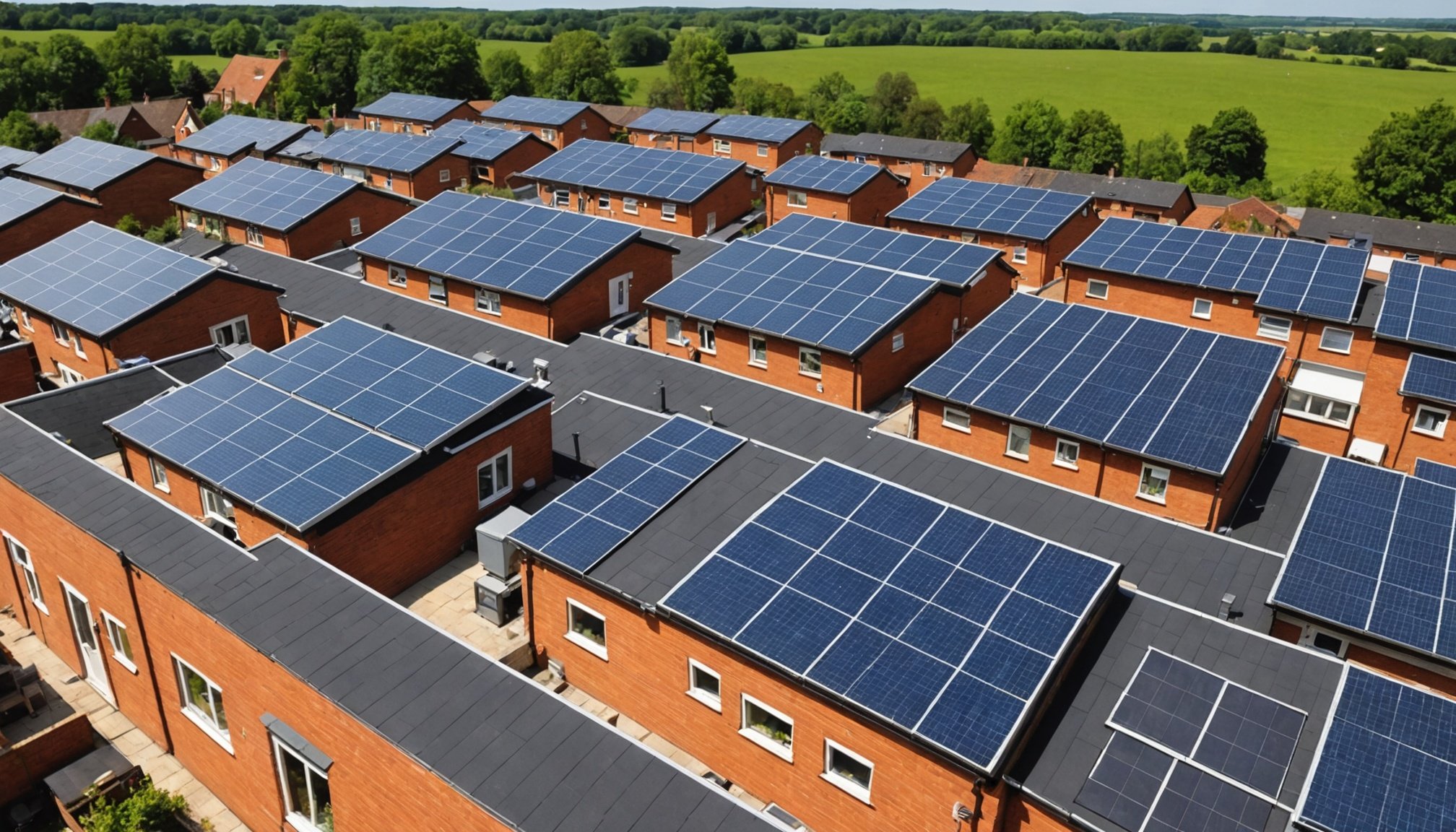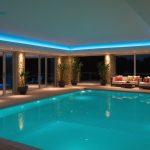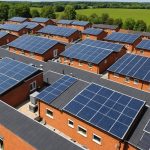Overview of Solar Panel Efficiency
Understanding solar panel efficiency is crucial for maximising the energy output of your solar energy system. Efficiency refers to the ability of the solar panels to convert sunlight into usable electricity. Several factors significantly impact solar panel performance.
Orientation and tilt are among the primary factors that influence solar panel efficiency. Panels should ideally face true south and be tilted at an angle equal to your latitude to capture maximum sunlight. Proper orientation and tilt can enhance the solar panel performance by ensuring they receive optimal sunlight exposure throughout the day.
Additional reading : Enhance your building's aesthetics with expert fencing and cladding
When comparing different types of panels, it’s evident that their energy output varies. Monocrystalline panels typically offer the highest efficiency, delivering more electricity with less space. On the other hand, polycrystalline panels, while less efficient, are more budget-friendly. Thin-film panels are lightweight and flexible, but generally provide lower energy output than their crystalline counterparts.
The local climate and sunlight availability in areas like Reading play a pivotal role. Consistent sunshine increases electricity generation, while overcast climates necessitate more panels or choosing types with enhanced low-light performance to maintain efficiency.
This might interest you : Discover the Ultimate Water Heating Solutions for UK Homes: What’s the Most Energy-Efficient Method?
Unique Considerations for Terraced Roofs
When considering solar panel installation on terraced roofs, it’s essential to address specific challenges and options. Terraced homes often face structural challenges due to limited space and varying roof slopes. These unique conditions make planning and executing installations more complicated than on traditional, flat surfaces.
Installation Challenges
Terraced roofs usually present installation challenges like weight distribution and pitch variation. Installers need to ensure that the roofing structure can support the weight of the panels. Failure to account for these constraints can lead to structural damage or inefficiencies in energy capture.
Structural Considerations
For terraced homes, it’s vital to assess the structural considerations before any installation. In some cases, reinforcing the roof might be necessary, or choosing lightweight solar panel materials can help accommodate the building’s constraints. Professionals can conduct a thorough inspection to propose the most effective solutions.
Rooftop Solar Options
Several rooftop solar options cater specifically to terraced roofs. For instance, smaller or more flexible solar panels can be an excellent choice for sloped areas. Additionally, mounting systems designed for limited spaces can optimize the available energy-generating potential even in unconventional spaces. Each option demands careful consideration, ensuring the balance between practicality and efficiency.
Local Regulations and Guidelines in Reading
Navigating local solar regulations is crucial for any property owner considering solar panels. In Reading, understanding these requirements can significantly impact your project’s success. Initially, it’s vital to comprehend the legal framework surrounding solar installations. This includes any zoning laws, permits, or restrictions that might affect the positioning and size of your solar array.
Planning permission is a common hurdle, especially for properties with terraced roofs. Generally, these permissions are necessary to ensure your installation does not negatively impact the aesthetic or structural integrity of the building. The key is to ensure that the solar panels are not excessively protrusive and adhere to the street’s characteristic features.
Furthermore, compliance with installation standards is non-negotiable. These standards ensure that systems are safe, efficient, and reliable. They often cover aspects like electrical connections, panel mounting, and inverter placements. Abiding by these can maximize both the safety and the efficiency of your solar installation, ensuring that you derive the maximum benefit from your investment.
By adhering to all these guidelines, you not only abide by the law but also protect your investment and potentially increase your property value.
Ideal Panel Arrangements for Maximum Efficiency
Achieving the most efficient solar layout design involves carefully considering your roof’s dimensions and angles. Understanding the relationship between these aspects and the overall panel arrangements is crucial for maximizing electricity generation. A common recommendation is to align panels perpendicular to the sun’s rays, as this orientation ensures that sunlight exposure is optimal.
Recommended Panel Layouts
Roof dimensions significantly influence how panels are arranged. For flat roofs, an angular mount can be used to adjust panels to the ideal tilting angle, typically around 30 to 45 degrees, tailored to your geographical location. For pitched roofs, panels should follow the roof’s natural inclination but might need slight adjustments for optimizing sunlight exposure.
Optimal Tilting Angles
Analysing optimal tilting angles involves considering the seasonal path of the sun. Modifying angles to align more closely with the sun’s peak position can enhance efficiency. Even minor adjustments in tilting can lead to significant gains in energy output.
Case Studies in Reading
Some successful panel arrangements in Reading have demonstrated substantial increases in efficiency through strategic layout designs. These examples highlight that custom approaches based on specific roof challenges can lead to optimal performance.
Addressing Shading Issues
Shading is a common concern when optimizing solar panel efficiency, particularly on terraced roofs. Identifying the sources of shade is crucial in addressing these issues effectively. Often, nearby structures or tall trees can obstruct solar access, diminishing the panels’ productivity. To help homeowners pinpoint these obstacles, utilizing solar path analysis tools can be invaluable. These tools assess shading patterns throughout the year, providing a comprehensive understanding of the impact on solar efficiency.
Mitigation strategies are essential once sources of shade are identified. For instance, trimming or strategically removing branches can significantly improve solar access. Similarly, it’s worth considering shading solutions such as repositioning panels or opting for higher efficiency models that perform better despite partial shading. Reflectors might also be employed to direct additional sunlight onto shaded panels, although the feasibility varies depending on the layout of the roof and surrounding environment.
In essence, a combination of insightful analysis and targeted shading solutions can dramatically enhance solar panel performance on terraced roofs, ensuring optimal energy generation throughout the year. These strategies empower homeowners to maintain efficient and sustainable energy solutions, despite challenges posed by their surroundings.
Maintenance and Installation Tips Specific to Reading
When addressing solar panel maintenance in Reading, it is important to adopt practices that ensure long-term efficiency. Routine cleaning is essential, particularly given Reading’s urban setting, which might lead to a build-up of dust and debris on panels. Use soft brushes and purified water to prevent scratches and water spots. Inspect for any damage after severe weather, as Reading may experience hail or strong winds that impact solar panel performance.
In terms of installation tips, Reading’s local climate impact should be considered. The best time for installation is during the mild spring months when weather conditions are stable. This maximizes working time and safety, reducing the risk of delays caused by unexpected weather changes. Proper angling and placement of panels to optimize sunlight exposure, while avoiding shading from nearby trees or buildings, will enhance efficiency throughout the year.
Weather factors like rainfall and extended cloudy periods can affect solar panel efficiency. However, Reading’s moderate climate typically allows for good solar energy production. Regularly check and maintain sealing and mounting fixtures to ensure they withstand environmental conditions, preserving solar panel longevity and reducing maintenance needs.
Visual Aids and Resources
Understanding the arrangement of solar panels can be challenging, but visual aids such as solar diagrams make this task simpler and more intuitive. These diagrams provide a bird’s-eye view of how panels should be optimally positioned to maximize sun exposure. Homeowners often benefit from visual resources that walk them through the installation process.
Local homeowners have access to numerous resources, including detailed guides that explain how solar energy systems work, as well as specific instructions for different types of homes. These resources are particularly valuable for those considering installations on terraced roofs, where unique challenges might arise, such as limited space and specific angling of the panels.
Installation guides often include how-to examples showcasing each step in the process. These examples use clear visuals to explain complex procedures, ensuring homeowners can follow along without confusion. For terraced roofs, certain guides might highlight potential difficulties and propose solutions, ensuring a smoother installation experience. By leveraging these visual aids and resources, individuals are empowered to make informed decisions about solar energy, offering a practical approach to harnessing renewable resources efficiently in their homes.











